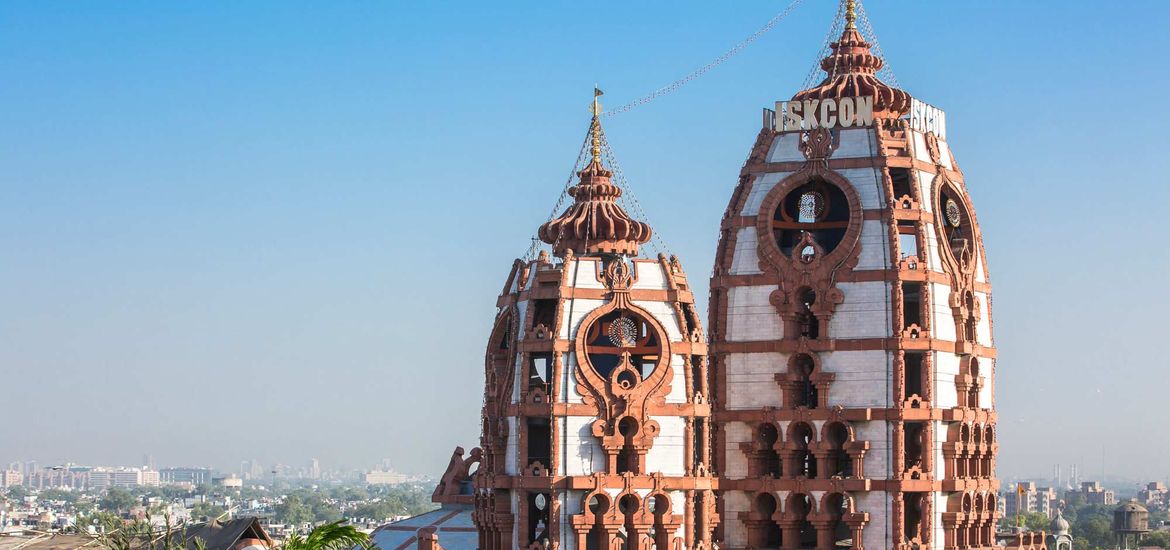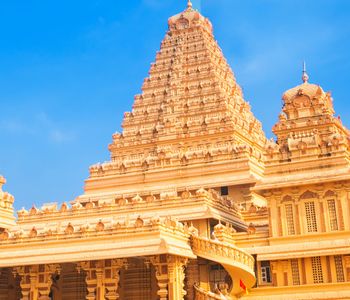Resting on three acres in New Delhi, the ISKCON Temple is a complex that was largely built and financially supported by ISKCON believers. Also known as the International Society for Krishna Consciousness Temple, this sacred place offers education, worshiping opportunities and other activities for both believers and visitors. Get to know this spiritual reprieve as you encounter the Gaudiya-Vaishnava denomination of Hinduism.
Constructing the Complex
The original Hare Krishna Movement began in the 1960s in New York City. As the movement grew, constructing a temple for its advancement was always a goal. Although the ISKCON Temple was scheduled for a 1995 unveiling, the complex wasn't completed until April 1998.
With only 250 construction workers, the project moved ahead as quickly as the work and funding were available. Ultimately, the project demanded several tons of stone, wood, stone chips, cement, steel and marble to create the six sections seen today. As a focal point, the towers offer lattice designs that reflect Hindu architecture.
Learning About the Various Sections
Indeed, this complex offers enlightenment, meditation and even housing for ISKCON followers. Altogether, six sections create the complex, including:
- Main temple
- Centre for Vedic Studies
- Museum of Vedic Culture
- Centre for Vedic Performing Arts
- Ashram or Residential Housing
- Krishna Jayanti Park
Typically, most visitors focus on the temple where most worship occurs. However, the Centre for Vedic Studies offers classes on Vedic philosophy, and the Centre for Vedic Performing Arts includes an amphitheater.
Also, the park is part history and meditation area because of its link to Krishna's early fables. Lastly, the Ashram is a safe space where followers can stay for extended periods as they study this fascinating religion.
Understanding the Worshiping Style
Although Hinduism focuses on polytheism or multiple gods, this denomination worships a single deity called Krishna. Indeed, visiting this temple gives you a taste of how worshiping Krishna occurs daily. For example, a Darshan or deity viewing occurs several times a day as the statues are unveiled for followers.
In addition, multiple aratis or offerings take place in the temple. Here, you might see incense, flowers or fans offered to the deity as believers chant various mantras. Certainly, praying and dance combine during worshiping, which makes this religion an uplifting and distinct practice compared to other spiritualities.
Exploring the Museum and Art Galleries
Visiting the Glory of India Vedic Cultural Centre is unlike any other museum. Because the museum focuses on advancing the understanding of Hindu scriptures, their teaching methods are unique. For example, Bhagavad Gita Animatronics teaches visitors about these concepts through projections, narrations and storytelling. By using visual aids, the museum can reach more people than with traditional exhibitions or lectures.
Also, a visit to the Ramayana Art Gallery gives you a look at ISKCON-inspired oil paintings. By browsing through these remarkable works, you gain a better understanding of this organization's mission and goals.
Dining and Preparing Food at the ISKCON Temple
The primary restaurant at this complex is Govinda's. Each day, any prepared food is offered to Krishna before being served to the people. With 18 items to choose from during lunch and dinner, every recipe is entirely vegetarian.
If you sign up to work at the restaurant, you can learn how to prepare these foods before they're offered to the deity. For a believer, this food-making process is a priceless way to feel closer to your spirituality. In the end, you can sign up for either lunch or dinner based on availability.
Daily Programmes and Timings
- The Darshan timings are 4:30 a.m. to 12:30 p.m. and 4:15 p.m. to 9:00 p.m.
- The daily program at ISKCON Delhi begins with the Mangal Aarti at 4:30 a.m. it is when the curtains are pulled to wake the deities.
- After the Mangal Aarti, you can attend meditation at 5:00 a.m.
- Darshan Aarti of the main temple begins at 7:15 a.m.
- Guru Puja for Sri Prabhupada takes place at 7:30 a.m.
- Attend the Srimad Bhagavatam Discourse at 8: 00 a.m. that discusses the stories and roles performed by Lord Krishna.
- Witness the Rajbhog Aarti offered to Radha-Krishna at 12:30 p.m.
- Attend the Usthapana Aarti at 5:00pm. It is the first Aarti of the evening.
- View the Sandhya Aarti, at 7 pm which is the main Aarti of the evening.
- Attend the Bhagavad Geeta discourse at 8:00 p.m.
- Sayana Aarti at 8:30 p.m. is the last Aarti of the day.
- Temple closing time is at 9:00 p.m.
- Prasadam timing of the day follows breakfast from 4:30 am to 8 am, lunch from 11:30 am to 2:00 pm, and dinner from 7:00 pm to 8:00 pm.
Showing Respect During Your Visit
Visitors are welcome to explore this denomination without committing to it. Overall, the ISKCON Temple is a safe place to explore your spiritual side. However, being respectful of this sacred place is critical. Ideally, wear clothing that covers the knees and shoulders. Although admission is free on the Temple's grounds, consider a small donation if you stay for an extended time.
Also, avoid taking photographs within the Temple. Typically, visitors reserve any photography for the exterior landscape. Being within the Temple calls for quiet reflection, meditation and exploring your beliefs.
Truthfully, visitors can enjoy the ISKCON Temple throughout the year. With several festivals focusing on deity worship, the Temple welcomes everyone to explore this unique Hindu denomination. In the end, any visitor can explore their spiritual side and find inner peace.












